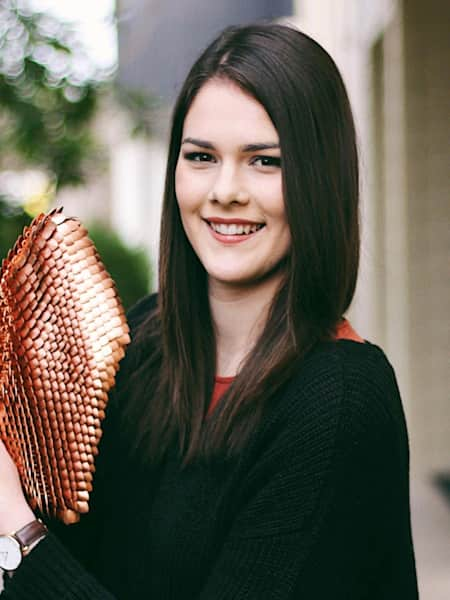Devastating the lives of more than 17 million people worldwide in 2018 alone, cancer is a disease that knows no bounds and doesn’t discriminate. Unfortunately for those diagnosed, the treatment can often feel even worse. Radiotherapy is often used to shrink cancerous growths, but it also has some particularly nasty side effects, including pain, damage to skin, sickness and more, and up until now it hasn’t been particularly easy to target cancerous growths exclusively.
Thanks to one innovative young Australian entrepreneur, however, those undergoing radiotherapy treatment for breast cancer – a cancer that one in every eight women will develop in their lifetimes – could be in for a slightly, if not easier, then at least more tolerable, ride. Macinley Butson’s SMART Armour (SMART standing for Scale Maille Armour for Radiation Therapy) is capable of shielding other areas of the body from harmful radiation, helping to minimise the side effects.
In simple terms, SMART Armour acts as body armour for people undergoing radiotherapy, shielding the contralateral breast (the breast not being treated) from excess radiation by up to 75 percent. The shield is created using high-density copper, and each one is hand made. According to Butson herself, the unique design and pattern was inspired from ancient armies, and is perfect for treatment as it can be draped, flexing to fit all shapes and individual treatments.
“SMART Armour is a project that I began exploring when I was around 15,” says Butson, now 18. “My father works in the field and has described what cancer patients had to go through. I decided it wasn't fair they would be subject to the side effects of radiation, which can cause skin burning, as well as the chance of another cancer forming, so I decided to dedicate my time to finding a solution since there wasn’t one already.”
It’s that selfless and entrepreneurial attitude that led to Butson becoming the first ever Australian to win first place at the INTEL International Science and Engineering Fair at just 16 years old, and since then the plaudits and awards have been piling up, including the NSW Young Australian of the Year, a place in the 2018 Top 100 Australian Female Influencers at the Australian Financial Review Awards, and numerous others.
“Cancer is something which affects so many people,” says Butson. “Whether you yourself have battled with cancer or know someone who has, it touches everyone’s lives. I simply didn’t think it was fair that a solution wasn’t already invented. My invention aims to aid the treatment of cancer; however, I would love to see a day where it's no longer needed because we have found a cure.”
SMART Armour isn’t Butson’s first foray into the world of science; she explains that a passion for STEM (Science, Technology, Engineering and Mathematics) and inventing things have been a core part of her for as long as she can remember. “I was always a curious child who would persistently annoy my parents with the most powerful question a child can ask. ‘Why?’ I had a natural passion and interest for the world which surrounded me and was eager to learn all of its secrets, in every nook and cranny and, how it was sustained smoothly. My parents never gave me a straight response, but rather encouraged me to discover the answer, so I would learn along the way.”
Growing up in an era where the internet has plenty of answers, Butson points out how useful the likes of Google can be if you are genuinely inquisitive and interested in making a positive difference. “My biggest support has always been my parents and I have also done a lot of research on my own, with Google as my best friend. The process of inventing is a long one, and most people only see the end product. Usually I spend a year on each of my projects, which start with theory research, and then experimental research. The inventing doesn’t actually start for a very long time.”
During that time, Butson faced plenty of challenges in developing SMART Armour. “There have definitely been times when I've wanted to give up,” she admits. “The scientific research process has many ups and downs, times where everything is going right and times where nothing goes right. But being able to do what I love and helping others at the same time through SMART Armour is what helps me to continue. I have a passion for science, but I also believe it’s always important to give back and help others. I’ve found that being both a young person and woman in the industry can be a challenge, but it’s never harder than the overall goal of helping others.”
For now, SMART Armour is currently halfway between the clinical and prototype stage. “We've finished all of the physical testing and it is ready to be used on a patient, we're simply finding a hospital to run a pilot study on it presently. We’ve had very positive feedback – of course, any radiation reduction without affecting treatment is a benefit, so we've had a lot of positive responses. We've also been able to change the design slightly and look at it from a different angle through some of the feedback, and we're very excited to see this out there and helping people as soon as possible.”
It’s not just those suffering from breast cancer that can potentially benefit from SMART Armour, either, and once the young entrepreneur has managed to push SMART Armour successfully through clinical trials, she’s also setting her sights on making treatment easier for other types of cancer as well.
“I originally designed it specifically for breast cancer but have since thought about application in other forms of radiotherapy. It could absolutely be applied – we're just researching this currently.”



